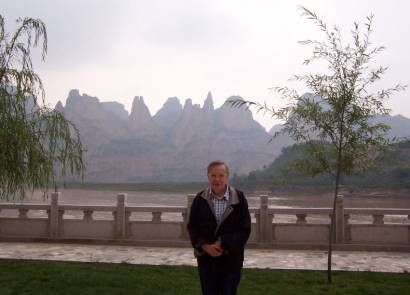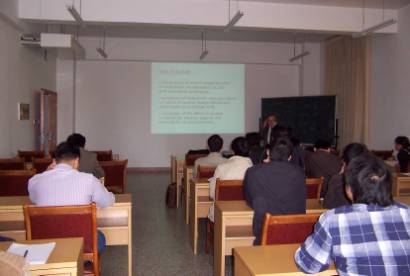Prof. W. Scheid from Institute of Theoretical Physics of the Justus Liebig University in Giessen, Germany, visited Institute of Modern Physics(IMP), CAS, Lanzhou from Sep.16 to 22, and gave talks on “Nuclear deformation in deep inelastic collisions of238U + 238U” and “Tev-acceleration of electrons with high-intense laser pulses in vacuum”. This is his 6th time visiting IMP.
He had very prominent contributions in the field of the atomic and nuclear heavy ion physics, acceleration of electrons by lasers, inverse scattering problem, and algebraic scattering theory. For the latest decades, he devotes himself to the study of the formation mechanism of super heavy nucleus, and had a long term collaboration with theoreticians from IMP supported by Natural Science Fundation of China and Deutsche Forschunggemeinschaft of Germany.
Since the nuclear shell model predicted that the next doubly magic shell closure beyond 208Pb is at a proton number between Z=114 and 126 and a neutron number Z=184, the outstanding aim of experimental investigation is the exploration of this region of superheavy elements. The investigation of the superheavy nucleus is an attempt to answer questions of fundamental character: How many elements may exist? How long is their lifetime? Which properties determine their stability? How can they be synthesized? What are their chemical properties? How are the electrons arranged in the strong electric field of the nucleus? Up to now new elements up to Z=118 have been synthesized in the lab in the world.
But superheavy elements are extremely difficult to be synthesized because the formation cross section is very small. So a better understanding of the physics conception on the superheavy nucleus is very important. Several theoretical models have been developed to describe the dynamical mechanism of the reaction. Among these models, W. Scheid’s group from Giessen has investigated the reaction mechanism of the superheavy element (SHE) formation in the concept of a dinuclear system (DNS). It is shown that the DNS model is a powerful tool to describe SHE production, and is the only model so far which gives no contradiction to available experimental data. The dynamical deformation in the formation process of SHE is very important, and no proper way to describe it so far. Prof.Scheid’s talk about the“Nuclear deformation in deep inelastic collisions of238U + 238U” has shed some light on the treatment of the deformation during the collisions.
His talk on “Tev-acceleration of electrons with high-intense laser pulses in vacuum” emphasized that short and intense laser pulses of an extension of about a half wave length can be applied to the acceleration of electrons. The laser pulse overruns the electron and let it return in an accelerated state. Plane laser pulses of a half wave length with a strength parameter lead to an accelerationinside a short distance. He suggested thatit is necessary that experimentally the electron acceleration with laser pulses has to be studied if one plans to construct new electron accelerators which accelerate electrons on short distances to very high energies (TeV regime).

Prof. W. Scheid from Institute of Theoretical Physics of Justus Liebig University in Germany(IMAGE/IMP)

|

